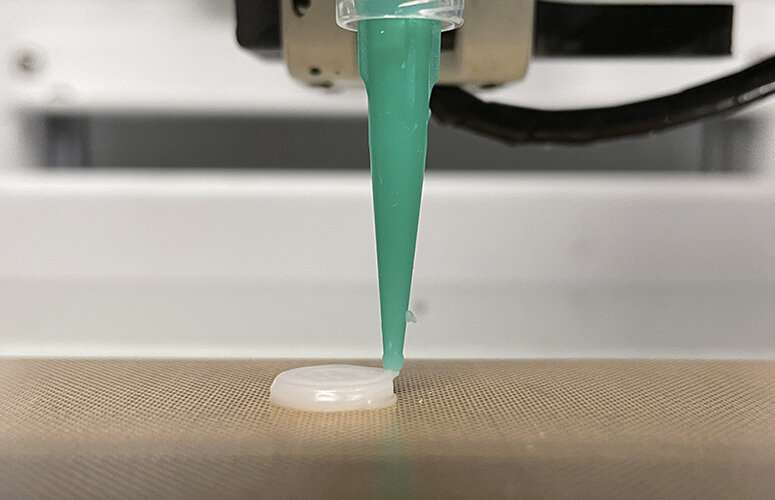3D printing of starch for personalized medicine development

Traditional methods produce medicines with specific parameters, but in many cases without meeting the individual needs of patients. In fact, conventional medicines tend to be based on adult doses, so pediatric and elderly patients require doses tailored to their age. What is more, certain groups of patients also need specific dosage form alternatives to facilitate the oral administration of drugs. In this respect, rapidly disintegrating tablets are emerging as a good option as they dissolve the moment they are placed on the tongue. Another challenge pharmaceutical companies need to address is the controlled release of the drug over time, especially when the drug is of a hydrophobic type (i.e., when dissolving it in water poses problems).
In this context, “3D printing technology is an advanced technique for personalized medicine and the development of on-demand drug-release tablets,” said Kizkitza González of the UPV/EHU’s Materials+Technologies Group (GMT). “The main aim of this work was to produce 3D printed starch-based tablets for the tailored delivery of hydrophobic drugs,” said the author of the paper published in the International Journal of Pharmaceutics.
3D printing is a technology that involves the printing of products layer by layer, in which materials are deposited according to the digital model designed by computer design software. Following a fast, simple methodology and thanks to 3D printing, “we were able to prepare tablets based on three types of starch—two types of maize starch (normal and waxy) and one type of potato starch– with different geometries and loaded with a non-soluble drug,” said Kizkitza González.
Maize and potato starch
“The material produced has to be inserted into a syringe before printing. However, before that you have to make sure that the material is going to be printable and that once printed it will keep its shape. To do this, a detailed rheological analysis has to be carried out,” explained the UPV/EHU researcher. The three types of starch have displayed appropriate rheological properties, although in the case of potato starch the printing process turned out to be more laborious due to its properties.
Furthermore, “we observed the importance of the botanic origin of the starch in practically all the properties, such as porous microstructure, the formation of a stable network or the release of the drug. In the case of normal maize starch, drug release is instantaneous and the drug is fully released within 10 minutes; in the case of waxy maize starch and potato starch, release is more continuous and can take up to 6 hours for full release. We were also able to demonstrate the importance of tablet geometry in drug release,” said Kizkitza González.
Finally, “tablets combining different types of starch were also printed. In this case, release takes place in two stages. For example, in the case of an infection, in an initial stage using normal maize starch, a medicine could be released immediately to alleviate pain, and in a subsequent stage, with either of the other two types of starch, an antibiotic could be released more continuously,” said the UPV/EHU researcher.
Kizkitza González is aware that this work is only the first stage in a long process, but she maintains that “the starch-based 3D printed tablets they produced displayed promising properties for future personalized drug delivery applications.”
Researchers create ingredients to produce food by 3-D printing
Kizkitza González et al, 3D printing of customized all-starch tablets with combined release kinetics, International Journal of Pharmaceutics (2022). DOI: 10.1016/j.ijpharm.2022.121872
Citation:
3D printing of starch for personalized medicine development (2022, August 25)
retrieved 25 August 2022
from https://phys.org/news/2022-08-3d-starch-personalized-medicine.html
This document is subject to copyright. Apart from any fair dealing for the purpose of private study or research, no
part may be reproduced without the written permission. The content is provided for information purposes only.
For all the latest Science News Click Here
For the latest news and updates, follow us on Google News.

